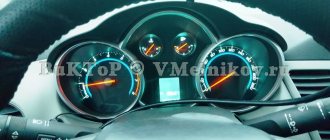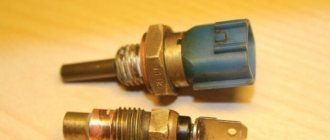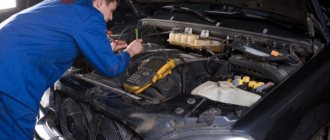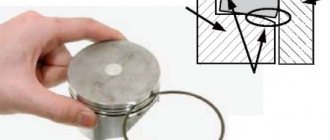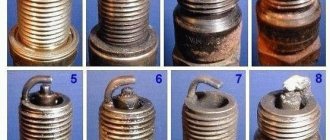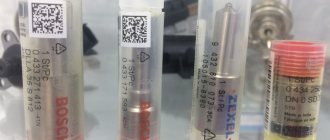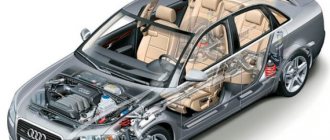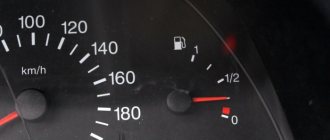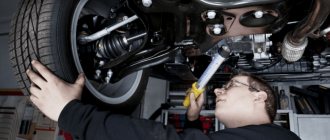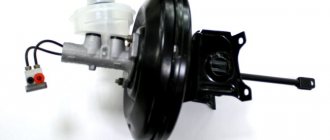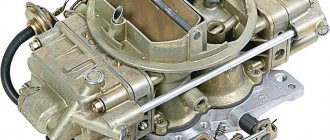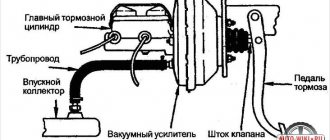The active introduction of electronic circuits into the design of a car gradually developed into the creation of a unified electronic engine control system (ECM) under the control of an ECU. In parallel with this, electronic control modules were equipped not only with the internal combustion engine, but also with other components and assemblies of a modern car. For example, control electronics control brakes, airbags, transmission, individual chassis components, etc.
We also recommend reading the article about what an ECM is. From this article you will learn about how electronic control systems for various components and assemblies work on modern vehicles.
For control and monitoring, the design of various systems contains numerous sensors that actively interact with the modules. Thanks to the presence of such modules, it is possible to quickly identify various malfunctions and failures, that is, computer diagnostics of the car engine and other components is performed. Next, we will talk about what computer diagnostics of the engine provides, how you can check the operation of the engine and other units, as well as where and how best to carry out this procedure.
What is computer car diagnostics?
The main condition for long-term and trouble-free operation of the car is diagnostics of the main systems and timely elimination of problems as they arise.
And if previously identifying a fault took a lot of time and had little accuracy, the use of new technologies has made it possible to quickly diagnose and repair breakdowns. What is computer car diagnostics? Car enthusiasts often do not understand the essence and features of such checks.
But here everything is simple. This is a test of electronic components and executive elements of the car that affect the functioning of the on-board system and the car as a whole. Using computer diagnostics, component faults are determined for further drawing up a special error map and correcting current faults.
When to get diagnosed?
Car enthusiasts avoid costs, so diagnosis often comes down to using “old-fashioned” methods or ignoring the problem. This approach leads to even more damage and costs in the future. To avoid problems, you should respond to the following symptoms of a malfunction:
- increased consumption of gasoline (diesel fuel) by car;
- malfunction of the accelerator pedal. When pressed, instead of accelerating, it slows down;
- the appearance of black and white exhaust;
- the occurrence of noises and knocks;
- increase in the warm-up time of the power unit (compared to previous indicators);
- reduction of power loss of the power unit.
The symptoms described above indicate obvious problems with the engine or other components of the car, which are determined by computer diagnostics. Checking will not be superfluous in the following cases:
- when buying a used car from a private owner;
- when independently preparing a car for sale. Carrying out diagnostics is a chance to accurately calculate the cost of the car;
- in a situation where the machine is used for a long time without repair;
- in cases where the car is used in extreme conditions (trips out of town, long journeys, difficult weather conditions, and so on).
Diagnostic methods
Video: How to use computer diagnostics for cars
You will also be interested in:
Before starting repairs, the technician determines which mechanism is faulty. This requirement is relevant for all mechanisms under study, be it an engine or a suspension. Today, diagnosis is carried out in three ways:
- using human senses such as smell, hearing and vision;
- inspecting the vehicle, using instruments and measuring basic parameters;
- carrying out electronic (computer) diagnostics.
In practice, all of the above methods are used. The only difference is the duration and accuracy of the procedure. The first method is the simplest, but is not very accurate. The second is accurate, but involves a time investment. The ideal option is computer diagnostics of the car. Its essence is scanning nodes controlled by a microprocessor.
Check Features
New car models have an ECU (electronic control unit), which records current errors and notifies the driver of problems with a particular component. All faults are detected using special complexes. The service includes:
- car engine diagnostics, checking the operation of all sensors, controllers and systems;
- diagnostics of the correct operation of the crank group and ECU.
Car diagnostic program
Once all checks are completed, the current faults appear on the monitor screen. Next, the program reconfigures the ECU (if there are any violations). If the problem is a fuel system failure, the program determines a repair option. In addition to the engine, fuel system and cooling system, other systems are checked - the gearbox and chassis components of the car. With a comprehensive diagnosis, the likelihood of missing something is minimal. The specialist accurately determines the malfunction, which saves time searching for the problem and money on repairing serviceable parts.
Diagnostic nuances
Video: Computer diagnostics of the ELM327 car (Part 1)
A popular test is engine diagnostics, which is carried out using a scanner and a motor tester. First, the nodes are scanned - electronic diagnostics. The scanner is a personal computer (or laptop), which is connected via a diagnostic connector and reads error codes. A special feature of such a device is its assistance in controlling mechanisms and deciphering signals sent from microprocessor sensors. In practice, scanning is not enough to determine the fault. To obtain accurate results, a motor tester is used - a multichannel oscilloscope. The purpose of the device is to measure signals received from the on-board computer, display oscillograms and other data on the screen. Additional information allows you to draw accurate conclusions about the malfunction and decide what to do next. The equipment described above is available in two types:
- Stationary motor testers are devices designed for multifaceted vehicle diagnostics. In such systems, OBD-II is only a small part of the gas analyzer system, reading compression parameters, pressure in the fuel system, and so on;
- dealer scanners (specialized devices) are digital products that are multifunctional. It is essentially a combination of a small computer, an oscilloscope and a multimeter. The cost of a specialized device exceeds 2-3 thousand dollars, so you can only find it at a specialized service station.
Despite its accuracy and simplicity, computer diagnostics of a car takes some time. The problem cannot be identified instantly. The average duration of tests is 20-30 minutes, because specialists at the service station not only read error codes, but also decipher the ECU readings.
Is it possible to carry out diagnostics yourself?
It is possible to conduct a preventive examination yourself. You need to purchase an adapter with an OBD-II connector and download a special diagnostic program to your computer, laptop, tablet or phone. When purchasing, pay attention to whether the equipment is suitable for the car brand.
Connect the scanner, start the engine, then the program. The screen will display information about the system status, error codes and decryptions.
Self-diagnosis is less functional than a procedure in a specialized service, but it is suitable as a way to monitor the condition.
Stages of computer diagnostics of a car
Computer diagnostics of a car engine
Computer diagnostics includes testing of car electronics and units responsible for the operation of the main components of the vehicle - engine, suspension, cruise control, transmission, navigation, dashboard, and so on. The work takes place in several stages:
- Vehicle components are checked using available diagnostic tools, basic data is taken from vehicle components, and errors are read. At this stage, the service station worker must correctly decipher the scanner readings and draw preliminary conclusions about the malfunction;
- At the second stage, additional analog testing is done. The electrical part of the car is checked - wires, batteries, contact connections, generator. The master determines whether the system is working or not. Otherwise, the rest of the data will not matter;
- Vehicle parameters are checked online. The option name is “Data Strea”. Flow information is a chance to check signals from executive bodies and other elements. In this mode, the main parameters are visible on the screen of the testing device - fuel injection, sensors, idle mode, and so on;
- The data obtained during the verification process is analyzed. As already mentioned, the scanner produces basic oscillograms, which should be compared with typical ones for each car. Usually a qualified technician will have all this information at hand;
- Errors recorded in the controller memory are erased. After this, reinitialization is carried out. In some cases, it is necessary to repeat the initialization work (if the main parameters have been reset).
Car self-diagnosis
The engine operating modes in new cars are controlled by an electronic system consisting of software and hardware. Thanks to them, the car engine operates at optimal parameters at any time, consumes less hydrocarbons and produces less harmful carbon dioxide. The hardware of the engine control system consists of a microprocessor and sensors that allow monitoring the necessary performance indicators of the unit. The software part is an executable program that contains optimal data for engine operation and directly controls the injection system. During execution, it compares the data received from the sensors with the initial ones and if there are unacceptable deviations, it writes an error code and issues a signal on the dashboard display. Depending on the make of the car, the signal may vary. Basically, the “Check Engine” sign flashes, just “Check” or the engine icon starts flashing. This verification procedure is called self-diagnosis (or self-diagnosis) of the engine control system. When “Check Engine” appears, an emergency program is also launched, which will be executed until the malfunction is eliminated. After the sensor values return to normal, the signal on the dashboard disappears, and the engine control system operates according to the main program. All error codes that occur while the engine is running are recorded in memory, and they can be read and see what happened to the engine or other system. There are two ways to read self-diagnosis codes. The first method is to connect the scanner to the diagnostic connector, with which you can display not only the error codes of the procedure on the screen, but also see their description. But not everyone has a scanner; mostly such devices are bought by car repair shops or people who do their own repairs. The second reading method is provided by the vehicle’s electronic system itself. In this case, the above-mentioned “Check Engine” signal will flash visually the error code by the number of flashes. Now let’s take a closer look at how to read self-diagnosis codes. In order to enable their display, it is necessary to short-circuit contacts E1 and TE1 on the diagnostic connector with a jumper; this is for imported cars. For our domestic vehicles, for example VAZ-21213, the display is turned on by closing contacts A and B. After installing the jumper, you need to start the car. The code display system is as follows: each code is repeated three times, the very first is code 12, indicating that the self-diagnosis has successfully completed initialization. If 12 does not pass, then there is a problem with the system and it will not be possible to count errors. After initialization, the recorded error codes are issued sequentially. One "Check Engine" flash indicates the number 1, for example, to display a code 14, "The Check Engine will flash once, then there will be a short pause to indicate the completion of the digit, then flash four times with a shorter pause (digit 4). There will be a long pause after this, indicating that the code is complete. Don't forget, each error code is repeated three times. To reset self-diagnosis codes, simply disconnect the vehicle battery for 20-30 seconds, after which all codes will be erased. The delay is caused by the presence of condensing elements in the hardware. This reading procedure is suitable for almost all modern cars. It is worth mentioning separately about Nissan cars. They display codes using two LEDs located directly on the control board. The board is located in a hard-to-reach place under the front passenger seat on the left side. Having reached it, you need to start the car and use a slotted screwdriver to turn on the mode for displaying self-diagnosis codes by turning it clockwise all the way. If everything is normal with the power supply, both LEDs should light up simultaneously. If this does not happen, then there is a problem with the power wiring. The red LED will flash the number of tens in the code, and the green LED will indicate the number of units. For example, by flashing red twice and green once, the device indicates that error code is 21. For different Nissan models, the specifics of reading codes may vary slightly. To erase codes in such cars, it will not be enough to simply disconnect the battery terminals for half a minute, because the control unit stores the value without power for a day. To erase data on a Nissan, with the engine running, use a screwdriver to turn the mode on the controller all the way, first clockwise and wait 2 seconds, then turn the mode all the way counterclockwise and wait the same amount of time.
Troubleshooting a vehicle's fuel system || How to choose a contract engine
| The comfort of a car ride depends on the condition of the chassis, and malfunction and wear of any of its elements leads to increased vibration and shaking. To avoid this from time to time... | Electronic car diagnostics.Computer diagnostics of a vehicle is testing of its electronic systems and mechanisms. It serves to identify faults in these systems and compile diagnostic… |
GENERAL INFORMATION
Modern cars, as a rule, are equipped with electronic systems that provide optimal control of the engine, transmission, brakes, etc. In most cases, each of them is “managed” by its own electronic control unit, operating according to a certain program in automatic mode. This eliminates the need for input and output devices for constant external intervention in the work process (monitor, keyboard, etc.). The need for communication with the electronic control unit and access to the readings of the self-diagnosis system arises only at the stage of vehicle maintenance or repair and is carried out using special methods. Troubleshooting
complex electronic devices is not an easy task, especially since their functioning in the vehicle’s electrical system is interconnected.
Objective diagnostics of electronic automation is possible only with the use of special tools, devices and equipment. It includes a set of actions, commonly called “computer diagnostics”. During its implementation, various operating parameters of the engine and vehicle are measured and compared with reference values. Diagnostic technology
involves mandatory verification of data received from the self-diagnosis system by measuring the relevant physical parameters.
For example, if an error code appears on the scanner display (see below), deciphered as “No signal from the coolant temperature sensor,” this does not mean that the sensor itself has failed. The fault may be in the wires connecting the sensor and the control unit, in the connectors, in the control unit itself, etc. To detect a fault, it is necessary to take a certain number of measurements of voltages, currents, resistances and determine the location of the damage. Based on the results obtained, malfunctions of individual systems, components, and assemblies are identified, then, taking into account indirect performance indicators, their technical condition is analyzed. Ultimately, it becomes possible to reliably assess the technical condition of the car, detect and eliminate the causes of deviations from the norm. Equipment necessary for diagnostics
can be divided into two groups: - instruments designed to measure physical quantities - ammeters, voltmeters, ohmmeters, pressure gauges, etc.; - devices that allow you to display in digital or graphic form the processes occurring during operation - scanners and motor testers. The main requirements for such devices are as follows: - completeness and accuracy of the information obtained, ease of operation, versatility; — availability of a reference data base for the largest number of brands and models of cars.
Three groups of devices
When performing complex diagnostics, complex equipment is involved - three main groups of devices, each with its own tasks.
The fundamental difference between diagnosing a car and its maintenance is the absence of requirements for standard time indicators for its implementation, as well as for the mileage of the car.
Those. You can stop right on the road and use special devices to immediately diagnose your car, if of course you have them.
Thus, the diagnostic area should contain:
- Motor tester;
- Scanner;
- Gas analyzer.
Let's talk about each of these devices separately.
MEASUREMENT OF PHYSICAL QUANTITIES
Multimeters
are designed for measuring DC and AC voltage, AC and DC current, resistance, engine speed, temperature, contact angle, as well as testing diodes and transistors. Many of these devices allow you to record measured values, have an automatic shutdown function, as well as protection against incorrect connection and overload. Multimeters are necessary in any car service center and can be very useful for car enthusiasts. At the same time, they have a relatively low cost and high reliability.
Pressure gauges
of various types and purposes are used to measure the pressure of gases and liquids in vehicle systems and components.
An electronic pressure meter
is designed to determine the pressure of fuel, engine oil and control pressure in an automatic transmission, compression in gasoline engines, as well as vacuum in the intake manifold. The presence of a set of adapters allows you to service almost any imported and domestic vehicle.
Motor testers
They are quite complex devices that require certain knowledge and skills to use. Earlier models are devices for determining the operating parameters of ignition systems using an oscilloscope. Only when using them is it possible to measure high-frequency pulses created by ignition systems, since they have a duration of less than a millisecond with a voltage amplitude of up to 30 kV. Many modern motor testers are modular devices that do not have built-in devices that display results or measurements and must be connected to a computer. Using motor testers, they measure any voltages and currents, as well as pressures (discharges) of gases and liquids in various engine systems and components. Based on the data obtained, carburetor and injection engines with a classic, electronic or microprocessor ignition system are diagnosed. Motor testers allow you to quickly and objectively determine faults in the ignition, fuel supply, and gas distribution systems, as well as check the operation of the generator and battery charging. To do this, they include tools for statistical processing of the received data.
What kind of maintenance is there?
Do not forget that before each trip by car the driver must carry out visual maintenance (inspection). That is, the driver must check:
- Tire pressure;
- Operation of lighting devices and direction indicators;
- The horn is working;
- Engine oil level;
- Coolant level;
- Brake fluid level;
- Power steering fluid level (if equipped);
- Washer fluid level.
All this is necessary in order to maintain the car in normal operating condition and ensure the safety of your trip, especially if the trip is long.
The rest of the maintenance should be carried out by qualified personnel of dealership centers or car service centers. For each car, the manufacturer sets its own standards, list of works and mileage during maintenance. But in most cases, those are:
TO - 0 is a zero maintenance, in common people it is called “Break-in” and is carried out after 1000 - 1500 km of the car. During such maintenance, the engine oil and oil filter are usually changed.
Maintenance - 1 is carried out after 15,000 miles, or a year of operation of the car, whichever comes first, regardless of whether the car has been driven or not.
Maintenance - 2 is carried out after 15,000 kilometers or a year of operation from the previous maintenance (whichever comes first)
Maintenance – 3 is carried out after 15,000 kilometers or a year of operation from the previous maintenance (whichever comes first)
Maintenance – 4 is carried out after 15,000 kilometers or a year of operation from the previous maintenance (whichever comes first)
And so on…
DEFINITION OF ERROR CODES
Error code scanners
are portable devices for reading fault codes. They are produced by various manufacturers under the names: Code-Reader, SmartTune, Creader, OBD II reader, etc. “Code readers” are mainly intended for small car services and car enthusiasts, as they are available and relatively inexpensive - for some models the minimum price is 1850 rubles per set. They can also be used for cars of the VAG group (Volkswagen Audi Group), which have their own connection system - four wires are connected in pairs. In many cases, scanners make it possible to quickly and easily determine faults, which is, in particular, necessary if the orange “Check engine” indicator lights up on the car’s dashboard. They are connected to the (OBD) connector, which is usually located inside the car. Then the ignition is turned on (the device can only be powered in this case) and four numbers appear on the liquid crystal display - an error code, which is deciphered from the attached book. During the process of determining the fault code, the scanner automatically tries to clear the error five times. If this fails, it can be assumed that there is serious damage and specialist intervention is required.
System scanner
is a small device with a color screen and a built-in miniature printer for printing reports. Modern versions of scanners have a minimum of buttons and information is entered using “touch screen” technology - by touching the screen. The device, according to a certain program, communicates with the electronic control unit, reads and displays information about operating parameters in an easy-to-read form. At the same time, it can perform the following functions: - reading and decoding error codes determined by the vehicle’s self-diagnosis system and stored in the memory of the control unit; erasing codes from memory, but the cause of the error is not eliminated; — display of vehicle operating parameters in real time; — impact on the control unit, sensors, actuators and their activation; — making changes to the operating program of the control unit within the competence of the service department and the technical capabilities of the scanner. The scanner communicates with the vehicle’s electronic systems in a “language” that is understandable to both parties, which is called a communication protocol and determines the set of “words” used and the order in which they are used. Since automakers often use their own original communication protocols, the scanner can only work with a certain list of car brands and models. Universal system scanners have advanced capabilities in this area.
COMPLEX DIAGNOSTICS
Diagnostic complexes
are designed to carry out the most complete monitoring of the technical condition of a vehicle based on the analysis of measurement results of various physical parameters, the composition of exhaust gases and software scanning of electronic control units. A personal computer with a liquid crystal screen, mounted together with other devices on a mobile stand, is used as a base. At the same time, it is possible to further equip the complex with additional devices and equipment to expand its functionality. The most optimal composition of a modern complex includes: - a high-speed digital six-channel motor tester; — four-component gas analyzer; — universal system scanner; - Personal Computer; - lockable mobile stand. The main advantage of such complexes is their wide range of functionality and the fact that all elements are located in a single mobile lockable rack, and the wires are hidden and protected from damage.
RECOMMENDATIONS
If signs of malfunctions are detected, it is necessary to carry out appropriate diagnostics, since when carried out in a high-quality manner, the following are eliminated: - the need to perform unnecessary repair operations; — the risk associated with the possibility of replacing serviceable parts; — unreasonable financial, temporary and moral losses. An assessment of the technical condition of a modern car equipped with electronic control systems is objective and reliable only if the diagnosis is carried out by a specialist who has undergone special training and uses the appropriate equipment. Computer diagnostics involves repeated confirmation and comparison with reference values of fault data obtained by various methods using appropriate devices and tools.
Types of diagnostics when repairing a car
- pre-repair
- post-repair
Pre-repair diagnostics, called pre-repair diagnostics in the technical literature, are carried out directly at the farms using the equipment or at service stations.
Diagnostics after repair, called post-repair, are performed at repair plants in order to assess the quality of the repair and the value of the restored repair.
Diagnostic methods are divided into subjective (organoleptic) and objective (instrumental). Subjective diagnostic methods include:
- visual inspection
- listening
- tapped
- test by touch and smell
An external inspection determines the condition of the seals, leakage of fuel, oil, electrolyte, damage to external parts; listening - knocks, noises and other sounds that differ from normal working ones; tapping - threaded, rivet, keyed and welding connections; touch - places where parts are heated, vibration, beating, liquid viscosity; smell - the condition of the clutch by its characteristic smell, gasoline leakage, etc.
To establish quantitative changes in the parameters of the technical condition of the machine, objective diagnostics are carried out, i.e. using special equipment and devices. The technical means may be built into or connected to the machine. Built-in sensors include sensors, signal lights, operating hours counter, filter clogging indicator, etc. Connected ones include stands, instruments, devices, etc.
What is engine diagnostics and what diagnostic methods are there?
There are many ways to diagnose an engine, but here are the main four:
- Visual diagnostics of engine components and assemblies
- Computer diagnostics of the engine, as well as other components and assemblies
- Instrumental engine diagnostics
- High-precision diagnostics with a motor tester
Let's look at each diagnostic method
To achieve the goal, it is necessary to understand when and how to use one or another type of diagnosis. In our experience of working with cars, often the absence of a “CheckEngine” light does not indicate the absence of a real problem in the engine .
The car's electronics cannot monitor the car's mechanical components. A modern car is very structurally complex and ambiguous, so it’s better to trust the professionals in their field.
So how to understand and make the right decision. Let's look at the types of diagnostics.
Visual diagnostics of components and assemblies.
A car service worker or someone who repairs your car must open the hood and visually inspect the engine compartment for visible defects. These include a torn wire, a torn hose, a lack of technical fluids, oxidation of wires, and so on.
This is often neglected not only in garage services, but also in large auto repair centers.
We always check the engine compartment and inform our customers about current faults. Very often we observe a lack of the required level of coolant, oil leaks, etc.
Computer diagnostics of the engine, as well as other components and assemblies
Many people think that computer diagnostics is a panacea for all problems . The car won't start, the tire has a flat, the gas has run out - no, computer diagnostics will not help with this.
Computer engine diagnostics are the eyes of the control unit, not the eyes of a mechanic or diagnostician. The computer does not give us complete information about a particular malfunction, but often confuses us and leads us down the wrong path.
Computer diagnostics only shows the further path for troubleshooting.
Each engine maintenance system has tolerances and there are parameters that the engine control unit cannot check or compare with the correct data. This suggests that the unit trusts the sensors, but the sensors can lie.
There is no error - is the machine working? Of course not. Indirectly, when diagnosing, you can understand where the trace of the problem leads, but do not hope for an easy solution to the problem.
Let's sum up the intermediate results.
Computer diagnostics are only a tool in troubleshooting . After all, the computer will not show physical quantities on the monitor display - fuel pressure, air leaks, engine compression, the performance of some sensors. Many people expect to undergo computer diagnostics and get all the information about the car - tire pressure, compression, temperature under the seat. Of course they won’t tell you this.
It is necessary to clearly understand that the car consists of 80% mechanical components and assemblies, and then electrical and electronics.
We are approaching the 3rd type of diagnosis.
Instrumental engine diagnostics
Example with fuel pressure.
Computer diagnostics let us know about the problem with the fuel. What's next? The computer won't help us anymore. We need a fuel pressure gauge. It is completely mechanical and the outputs are not transmitted by the engine control unit, but by We ourselves, based on the readings of the pressure gauge, whether there is a problem.
Let's take the example of compression.
Poor starting in cold weather. Different conclusions can be drawn - fuel pressure, bad spark plugs, clogged injectors. What if it's just bad compression? That's right, we need a compression gauge. I will not go into the description and principle of its operation, but I will say one thing - no computer diagnostics will show us compression. Only mechanical data collection from the compression meter.
There are many devices for instrumental diagnostics. I’ll just list the main ones - pressure gauge, compression gauge, smoke generator, pneumatic tester, pyrometer, stethoscope, video endoscope, vacuum gauge and electrical testers.
Bottom line
Computer diagnostics without visual and instrumental diagnostics is not a solution to the problem. You can visit many services and all to no avail, but by coming to Us and making a complete diagnosis, you will receive a 100% repair result .
We have come to the most complex and very effective diagnostic method
High-precision diagnostics with a motor tester
A motor tester is a device for connecting directly to the engine sensor and its mechanical part. We don’t need the scanner readings as such – it can only interfere with us.
Drawing preliminary conclusions
All the devices described above are completely different in principle of operation, but they complement each other.
In practice, you can do without any of the devices described above, but in this case the accuracy of the measurements will decrease. As for the rest of the equipment, it is purely auxiliary in nature.
In particular, a fuel pressure gauge is useful for measuring pressure, and special stands are useful for checking modules and spark plugs.
You will also need installation, kit and probes.
But having the necessary ones is one thing, because you also need to know the progress of operations when diagnosing a particular car system.
Computer diagnostics: goals and objectives
Computer diagnostics of the car helps to avoid software failures or malfunctions in the functioning of elements of complex mechanisms. As part of diagnostic activities, error codes detected during the analysis of the operation of the main components and assemblies are read and processed.
Diagnostic equipment includes specialized monitoring tools such as brand-specific diagnostic scanners, multi-function test benches, and hand-held readers known as “readers.” All these devices are connected to the car's diagnostic connector. Specialized computer equipment allows not only to record any changes in the operation of various systems, but also to erase detected error codes in order to correct them.
The driver can find out about possible defects and current errors in advance. The on-board systems of a modern car are equipped with an electronic control unit with a self-diagnosis function that analyzes the main systems of the car and notifies the driver of their malfunction.
Automakers recommend regularly conducting computer diagnostics of cars to ensure trouble-free operation of the most important vehicle systems. Only high-precision equipment, with the help of numerous electronic sensors and chips, is able to recognize a problem in the software of a particular node.
General information and information
Scheduled maintenance is necessary for the timely identification of faults in the electronic and mechanical systems of the vehicle in order to eliminate them. Maintenance work is also being carried out on the fuel system, which allows for a slight reduction in fuel consumption during vehicle operation.
Maintenance of a new car is necessary to eliminate so-called “hidden” faults. Not everyone will be able to notice a factory defect in the engine or brake system. If you leave all this unattended, you can get into an accident. Therefore, maintaining the car in good technical condition is simply necessary. The technical serviceability of a car is the maximum level of safety, comfort and efficiency that a given vehicle can provide. Therefore, if you want all systems to work properly for as long as possible, it is better not to skip maintenance at the dealer.
Stages of diagnostics
Computer diagnostics, regardless of the make and model of the car, includes several stages. Typically, it takes a specialist about 30 minutes to comprehensively diagnose all vehicle faults. The duration of analysis of one system, for example, ABS, takes about 10-15 minutes. To ensure that the service center employee has acted correctly, it is important for the car owner to know how the diagnostics are carried out.
- Typically, the first stage is general computer diagnostics, during which testing occurs without activating the main systems. Analog testing at this stage is carried out to check the electrical system, namely: connections, battery and generator.
- During dynamic testing, the machine is fixed on a stand equipped with special sensors, through which data on the operation of the systems is transmitted to a computer for further analysis.
- At this stage, the database collected by the on-board system is deleted (reset), and the control device is activated to collect information. Error codes recorded during the diagnostic process are deciphered using professional applications. As a result, the specialist receives accurate data about the problem of any electronic system of the car.
Detailed inspection
As a result, the specialist should get a complete picture in the following areas:
- Headlights and other lighting fixtures. At this stage, the inclination angle and adjustment of the devices are measured. The resulting value must comply with approved standards.
- Windshield wipers and windshield washers. The specialist must not only check their presence, but also how capable they are of performing their functions.
- The condition of the car tires and wheels in general. Operating a car with cuts, bumps, fastening problems, lack of bolts and nuts provided for by the design and signs of increased wear (cord threads are visible, the tread pattern is smaller than normal or completely missing, the frame is delaminate) is strictly prohibited; this requirement is established in the traffic rules. Also, you cannot operate vehicles using tires of different types, sizes and with inappropriate tread patterns.
- Steering unit condition. Depending on the vehicle, the operation of the hydraulic booster is checked (if the vehicle model requires its presence) and compliance with the permissible level of play (for cars up to 3.5 tons and cars, the value cannot exceed 10%).
- Car brake system. The specialist checks the effectiveness of braking, including emergency braking, and measures the braking distance of the car.
- Checking the engine, including using computer diagnostics.
- Exhaust gas analysis. The content of harmful substances should not exceed the permissible limit.
When to get diagnosed
Car manufacturers recommend carrying out comprehensive computer diagnostics at least once a year, provided that the car is in good condition and there are no icons with errors visible on the on-board computer. If strange sounds or jerks or jolts that are uncharacteristic of the car appear while driving, you should contact a reliable service center as soon as possible for a thorough diagnosis of all systems. This is also worth doing in the case when the machine does not warn of a breakdown, but you feel that its behavior has changed.
Computer diagnostics of a car engine is carried out if you notice that the engine makes strange sounds, is unstable, loses power, and fuel consumption has increased. During diagnostics, specialists usually check the injection system, the correct functioning of the electrical system, and also measure compression.
Diagnostics of an automatic transmission is indicated when problems occur with shifting gears, jerks, jolts and slips that are unusual for the car, or when an oil leak is detected.
The suspension should be checked if the car's tires wear unevenly and a loud knock is heard when maneuvering while driving. In addition to computer diagnostics, a service station employee is required to conduct a visual inspection of the faulty system and give the necessary recommendations for repairing the car.
Highly qualified specialists from the official service centers of the FAVORIT MOTORS Group of Companies carry out high-quality computer diagnostics using certified equipment recommended by foreign automakers. The high level of service and favorable cost of work for car owners are the main reasons for the trust of numerous clients of FAVORIT MOTORS Group. Modern diagnostic systems used in our service centers allow us to detect faults in a timely manner, significantly reducing the cost of maintaining and further repairing the vehicle.
